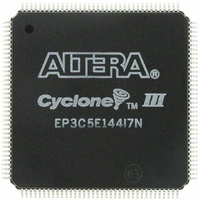EP3C5E144I7N Altera, EP3C5E144I7N Datasheet - Page 259

EP3C5E144I7N
Manufacturer Part Number
EP3C5E144I7N
Description
IC CYCLONE III FPGA 5K 144 EQFP
Manufacturer
Altera
Series
Cyclone® IIIr
Datasheets
1.EP3C5F256C8N.pdf
(5 pages)
2.EP3C5F256C8N.pdf
(34 pages)
3.EP3C5F256C8N.pdf
(66 pages)
4.EP3C5F256C8N.pdf
(14 pages)
5.EP3C5F256C8N.pdf
(76 pages)
6.EP3C5E144I7N.pdf
(274 pages)
Specifications of EP3C5E144I7N
Number Of Logic Elements/cells
5136
Number Of Labs/clbs
321
Total Ram Bits
423936
Number Of I /o
94
Voltage - Supply
1.15 V ~ 1.25 V
Mounting Type
Surface Mount
Operating Temperature
-40°C ~ 100°C
Package / Case
144-EQFP
Family Name
Cyclone III
Number Of Logic Blocks/elements
5136
# I/os (max)
94
Frequency (max)
437.5MHz
Process Technology
65nm
Operating Supply Voltage (typ)
1.2V
Logic Cells
5136
Ram Bits
423936
Operating Supply Voltage (min)
1.15V
Operating Supply Voltage (max)
1.25V
Operating Temp Range
-40C to 100C
Operating Temperature Classification
Industrial
Mounting
Surface Mount
Pin Count
144
Package Type
EQFP
For Use With
544-2601 - KIT DEV CYCLONE III LS EP3CLS200544-2411 - KIT DEV NIOS II CYCLONE III ED.
Lead Free Status / RoHS Status
Lead free / RoHS Compliant
Number Of Gates
-
Lead Free Status / Rohs Status
Compliant
Other names
544-2557
Available stocks
Company
Part Number
Manufacturer
Quantity
Price
Company:
Part Number:
EP3C5E144I7N
Manufacturer:
Altera
Quantity:
135
Company:
Part Number:
EP3C5E144I7N
Manufacturer:
ALTERA32
Quantity:
345
Part Number:
EP3C5E144I7N
Manufacturer:
ALTERA/阿尔特拉
Quantity:
20 000
Chapter 11: SEU Mitigation in the Cyclone III Device Family
Error Detection Timing
Table 11–4. Error Detection Registers
Error Detection Timing
© December 2009
32-bit signature
register
32-bit storage register
Register
Altera Corporation
Table 11–4
When the error detection CRC feature is enabled through the Quartus II software, the
device automatically activates the CRC process upon entering user mode after
configuration and initialization is complete.
The CRC_ERROR pin is driven low until the error detection circuitry has detected a
corrupted bit in the previous CRC calculation. After the pin goes high, it remains high
during the next CRC calculation. This pin does not log the previous CRC calculation.
If the new CRC calculation does not contain any corrupted bits, the CRC_ERROR pin is
driven low. The error detection runs until the device is reset.
The error detection circuitry runs off an internal configuration oscillator with a divisor
that sets the maximum frequency.
Table 11–5
Table 11–5. Minimum and Maximum Error Detection Frequencies
You can set a lower clock frequency by specifying a division factor in the Quartus II
software (for more information, refer to
divisor is a power of two (2), where n is between 0 and 8. The divisor ranges from one
through 256. Refer to
Equation 11–1. Error Detection Frequency
Cyclone III
device family
Device Type
This register contains the CRC signature. The signature register contains the result of the user
mode calculated CRC value compared against the pre-calculated CRC value. If no errors are
detected, the signature register is all zeros. A non-zero signature register indicates an error in the
configuration CRAM contents.
The CRC_ERROR signal is derived from the contents of this register.
This register is loaded with the 32-bit pre-computed CRC signature at the end of the configuration
stage. The signature is then loaded into the 32-bit CRC circuit (called the Compute and Compare
CRC block, as shown in
forms a 32-bit scan chain during execution of the CHANGE_EDREG JTAG instruction. The
CHANGE_EDREG JTAG instruction can change the content of the storage register. Therefore, the
functionality of the error detection CRC circuitry is checked in-system by executing the instruction
to inject an error during the operation. The operation of the device is not halted when issuing the
CHANGE_EDREG instruction.
lists the registers shown in
lists the minimum and maximum error detection frequencies.
Frequency
80 MHz/2
Detection
Error
Equation
Figure
n
Error detection frequency
11–1) during user mode to calculate the CRC error. This register
11–1.
Maximum Error
Frequency
Detection
80 MHz
Figure
Function
“Software Support” on page
11–1.
=
Minimum Error
80 MHz
----------------- -
Frequency
Detection
312.5 kHz
2
n
Cyclone III Device Handbook, Volume 1
0, 1, 2, 3, 4, 5, 6, 7, 8
Valid Divisors (2
11–6). The
11–5
ν
)















